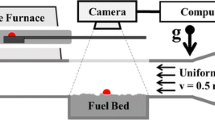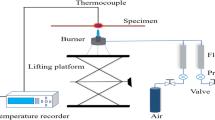Abstract
Wildland–urban interface fires are a severe fire hazard due to biomass ignition caused by arc beads. This study investigated how the energy, diameter, and number of arc beads affect biomass ignition probabilities. An improved experimental method was used to generate arc beads of various arc energies. Here, α-cellulose materials, which are well-characterised as biomass, were used as fuels. A high-speed camera recorded ignition phenomenology, revealing two ignition behaviours of rolling and embedding. The results revealed that an electrical fault arc energy of approximately 175 J was the most dangerous ignition condition. Ignition phenomenology was categorised into ignition and non-ignition, and it was observed that ignition could only occur during the bead rolling process. Contrarily, non-ignition occurred when its bounce even spun plenty of times. Ignition limits, namely the ignition region, potential ignition region, and non-ignition region, were determined. Furthermore, a novel predictive logistic regression-based ignition probability model was established, which indicated that the ignition occurrence of an arc bead was highly dependent on the diameter of the arc bead. The developed mathematical model can reasonably predict the ignition ability of biomass fuel ignition by arc beads.














Similar content being viewed by others
Abbreviations
- \(f_{{\mathrm{i}}}\) :
-
Predicted value
- g :
-
Dependent variable, between 0 and 1
- \(I_{{\mathrm{n}}}\) :
-
Value of the instantaneous current (A)
- N ig :
-
Number of tests resulting in flaming ignition
- N sum :
-
Total experiments
- P :
-
Probability of ignition (%)
- P model :
-
Predicted value of the ignition probability model (%)
- P 1 :
-
Observed ignition probability (%)
- P 2 :
-
Evaluation of ignition hazard (%)
- R 2 :
-
Correlation coefficient
- \(t_{{\mathrm{n}}}\) :
-
Arcing time (s)
- \(U_{{\mathrm{n}}}\) :
-
Value of instantaneous voltage (V)
- \(W_{{{\mathrm{arc}}}}\) :
-
Arc energy (J)
- x :
-
Independent variable, in this paper, indicated arc energy (J)
- y :
-
Dependent variable, in this paper, indicated bead diameter (mm)
- \(y_{{\mathrm{i}}}\) :
-
Actual value
- \(\overline{y}\) :
-
Average of the actual value
- z :
-
Independent variable, its variation range is in the real number interval
- \(\theta\) :
-
A parameter
References
Wu DC, Amini A, Razban A, et al. ARC algorithm: a novel approach to forecast and manage daily electrical maximum demand. Energy. 2018;154:383–9.
Rava A, Behzadmehr A, Sheikholeslami TF. Energy and exergy numerical analysis of alkali metal thermal-to-electric converter. J Therm Anal Calorim. 2022;147:10461–79.
Babrauskas V. Research on electrical fires: the state of the art. Fire Saf Sci. 2008;9:3–18.
Li Y, Sun Y, Gao Y, et al. Analysis of overload induced arc formation and beads characteristics in a residential electrical cable. Fire Saf J. 2022;131:103626.
Hadden RM, Scott S, Lautenberger C, et al. Ignition of combustible fuel beds by hot particles: an experimental and theoretical study. Fire Technol. 2011;47:41–55.
Manzello SL, Sayaka S. The importance of combustion science to unravel complex processes for informal settlement fires, urban fires, and wildland-urban interface (WUI) fires. Fuel. 2021;314:122805.
Babrauskas V. Electrical fires and explosions. New York: Fire Science Publishers; 2021.
Xinhua News Agency. The investigation results of the “3.30” forest fire incident in Xichang, Liangshan, Sichuan announced. https://doi.org/10.16859/j.cnki.cn12-9204/tu.2021.02.016.
Babrauskas V. Electric arc explosions—a review. Fire Saf J. 2017;89:7–15.
Rallis CJ, Mangaya BM. Ignition of veld grass by hot aluminium particles ejected from clashing overhead transmission lines. Fire Technol. 2002;38:81–92.
Babrauskas V. SFPE handbook of fire protection engineering (Electrical fires). 5th ed. New York: Springer; 2016.
Babrauskas V. Electrical fires: research needed to improve safety. Fire Prot Eng. 2010;46:20–30.
Babrauskas V. How do electrical wiring fault lead to structure ignitions. In: Proceedings of the fire and materials conference, London, UK; 2001. p. 39–51.
Lü HF, Deng J, Li Y, et al. Influence of thermal environment on metallographic structure characteristics of the electric arc bead pattern. J Loss Prev Process Ind. 2021;70:104426.
Babrauskas V. Arc beads from fires: can ’cause’ beads be distinguished from ’victim’ beads by physical or chemical testing? J Fire Protect Eng. 2004;14:125–47.
Lyu HF, Wang CP, Deng J, Wang WF, Li Y, Shu CM. Arc bead ignition of a cellulose fuel bed derived from experimental and simulated data. Fuel. 2023;339:127417
Brindley J, Griffiths JF, McIntosh AC. Ignition phenomenology and criteria associated with hotspots embedded in a reactive material. Chem Eng Sci. 2001;56:2037–46.
Lü HF, Deng J, Li DJ, et al. Effect of oxidation temperature and oxygen concentration on macro characteristics of pre-oxidised coal spontaneous combustion process. Energy. 2021;227:120431.
Fernandez-Pello AC. Wildland fire spot ignition by sparks and firebrands. Fire Saf J. 2017;91:2–10.
Sabi FZ, Terrah SM, Mosbah O, et al. Ignition/non-ignition phase transition: a new critical heat flux estimation method. Fire Saf J. 2021;119:103257.
Wang S, Huang X, Chen H, Liu N, Rein G. Ignition of low-density expandable polystyrene foam by a hot particle. Combust Flame. 2015;162:4112–8.
Wang S, Chen H, Liu N. Ignition of expandable polystyrene foam by a hot particle: an experimental and numerical study. J Hazard Mater. 2015;283:536–43.
Wang S, Chen H, Zhang L. Thermal decomposition kinetics of rigid polyurethane foam and ignition risk by a hot particle. J Appl Polym Sci. 2014;131:1–9.
Wang S, Huang X, Chen H, Liu N. Interaction between flaming and smouldering in hot-particle ignition of forest fuels and effects of moisture and wind. Int J Wildl Fire. 2017;26:71–81.
Li MY. Experimental study on the ignition of combustible bulk materials by a hot metal particle. University of Science and Technology of China, Hefei, Anhui Province, China, MS Thesis. 2017.
Yang J, Wang S, Chen H. Effect of interface thermal resistance on ignition of reactive material by a hot particle. Int J Heat Mass Transf. 2016;97:146–56.
Zak C. The effect of particle properties on hot particle spot fire ignition. University of California, Berkeley, California, USA, Ph.D. thesis. 2015.
Zak C, Urban J, Tran V, et al. Flaming ignition behavior of hot steel and aluminum spheres landing in cellulose fuel beds. Fire Saf Sci. 2014;11:1368–78.
Yin P, Liu N, Chen H, Lozano JS, Shan Y. New correlation between ignition time and moisture content for pine needles attacked by firebrands. Fire Technol. 2014;50:79–91.
Urban JL. Spot ignition of natural fuels by hot metal particles. University of California, Berkeley, California, USA, Ph.D. thesis. 2016.
Urban JL, Zak CD, Fernandez-Pello C. Cellulose spot fire ignition by hot metal particles. Proc Combust Inst. 2015;35:2707–14.
Urban JL, Zak CD, Fernandez-Pello C. Spot fire ignition of natural fuels by hot aluminum particles. Fire Technol. 2018;54:797–808.
Urban JL, Song J, Santamaria S. Ignition of a spot smolder in a moist fuel bed by a firebrand. Fire Saf J. 2019;108:102833.
Urban JL, Zak CD, Song J, et al. Smoldering spot ignition of natural fuels by a hot metal particle. Proc Combust Inst. 2017;36:3211–8.
Wang Q, Liu K, Wang SP. Effect of porosity on ignition and burning behavior of cellulose materials. Fuel. 2022;322:124158.
Wu XX. Investigate on the sputter erosion model of electrical arcing contact and its experimental. Huazhong University of Science and Technology, Wuhan, China, PhD Dissertation. 2005.
Wu D, Tashiro S, Hua X, Tanaka M. Analysis of the energy propagation in the keyhole plasma arc welding using a novel fully coupled plasma arc-keyhole-weld pool model. Int J Heat Mass Transf. 2019;141:604–14.
Zak CD, Urban JL, Fernandez-Pello C. Characterizing the flaming ignition of cellulose fuel beds by hot steel spheres. Combust Sci Technol. 2014;186:1618–31.
Ghazvini K, Yousefi M, Firoozeh F, Mansouri S. Predictors of tuberculosis: application of a logistic regression model. Gene Rep. 2019;17:100527.
Hosmer DW, Lemeshow SA, Sturdivant RX. Applied logistic regression. 3rd ed. Hoboken: Wiley; 2013.
Stankovic B, Jovanovic J, Adnadjevic B. Application of logistic function to describe kinetics of non-isothermal dehydroxylation of fullerol. J Therm Anal Calorim. 2019;138:2295–303.
Daniels LB, Clopton P, deFilippi CR, et al. Serial measurement of N-terminal pro-B-type natriuretic peptide and cardiac troponin T for cardiovascular disease risk assessment in the Multi-Ethnic Study of Atherosclerosis (MESA). Am Heart J. 2015;170:1170–83.
Hanley JA, McNeil BJ. The meaning and use of the area under a receiver operating characteristic (ROC) curve. Radiology. 1982;143:29–36.
Cook NR, Ridker PM. Advances in measuring the effect of individual predictors of cardiovascular risk: the role of reclassification measures. Ann Intern Med. 2009;150:795–802.
Tewarson A, Khan M. A new standard test method for the quantification of fire propagation behavior of electrical cables using factory mutual research corporation’s small-scale flammability apparatus. Fire Technol. 1992;28:215–27.
Zapico EP, Lutey AHA, Ascari A, et al. An improved model for cold metal transfer welding of aluminium alloys. J Therm Anal Calorim. 2018;131:3003–9.
Lautenberger C. A generalized pyrolysis model for combustible solids. University of California, Berkeley, California, USA, PhD thesis. 2007.
Viegas DX, Almeida M, Raposo J, et al. Ignition of mediterranean fuel beds by several types of firebrands. Fire Technol. 2014;50:61–77.
Esclapez L, Collin-Bastiani F, Riber E, Cuenot B. A statistical model to predict ignition probability. Combust Flame. 2021;225:180–95.
Huang X. Critical drip size and blue flame shedding of dripping ignition in fire. Sci Rep. 2018;8:16528.
D’Agostino RB, Nam BH. Evaluation of the performance of survival analysis models: discrimination and calibration measures. Handb Stat. 2003;23:1–25.
Gerds TA, Cai T, Schumacher M. The performance of risk prediction models. Biom J. 2008;50:457–79.
Acknowledgements
This study was funded by the National Natural Science Foundation of China (No. 52074213), the Natural Science Youth Foundation of Shaanxi Province (2023-JC-QN-0398); the Natural Science Youth Foundation of Hebei Province (E2021507002); the Program of CSC funded by China Scholarship Council (No. 202008610260). In addition, the authors gratefully acknowledge the technical assistance of Prof. Drebenstedt Carsten of Technical University Bergakademie Freiberg (Germany).
Author information
Authors and Affiliations
Contributions
H-FL was involved in article ideas and experimental tests, and wrote the paper. C-PW further deeply discussed experimental ideas. JD completed the data testing. W-FW completed the data analysis. YL improved analysis methods. C-MS helped in review and editing.
Corresponding authors
Ethics declarations
Conflict of interest
The authors declare that they have no known competing interests that could have shown to affect the work appeared in this paper.
Additional information
Publisher's Note
Springer Nature remains neutral with regard to jurisdictional claims in published maps and institutional affiliations.
Rights and permissions
Springer Nature or its licensor (e.g. a society or other partner) holds exclusive rights to this article under a publishing agreement with the author(s) or other rightsholder(s); author self-archiving of the accepted manuscript version of this article is solely governed by the terms of such publishing agreement and applicable law.
About this article
Cite this article
Lyu, HF., Wang, CP., Deng, J. et al. Ignition ability prediction model of biomass fuel by arc beads using logistic regression. J Therm Anal Calorim 148, 4745–4757 (2023). https://doi.org/10.1007/s10973-023-12023-5
Received:
Accepted:
Published:
Issue Date:
DOI: https://doi.org/10.1007/s10973-023-12023-5




